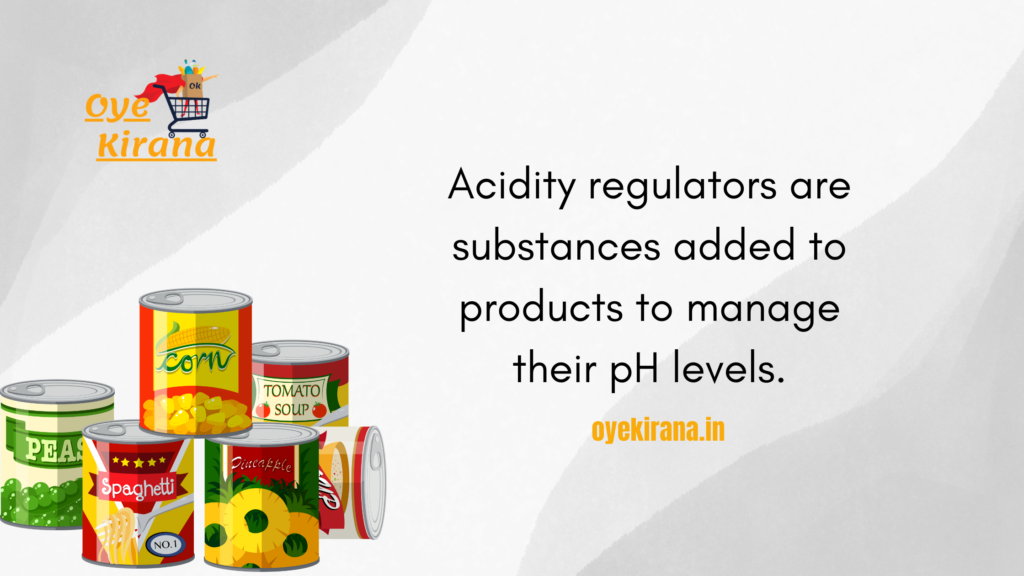In the world of food and beverage manufacturing, acidity regulators play a crucial role in maintaining the perfect balance of flavors and freshness. Imagine biting into a perfectly tart lemon or sipping a refreshing soda with just the right amount of tang. What you might not realize is that the consistent taste, texture, and quality of these everyday foods and drinks owe much to an often-overlooked ingredient: acidity regulators. These unsung heroes are at the heart of maintaining the flavors and freshness we enjoy.
In this blog, we aim to shed light on the fascinating world of acidity regulators. We’ll explore the different types of acidity regulators, their diverse applications across industries, and the benefits they offer. Additionally, we’ll discuss safety considerations and emerging trends, helping you make informed decisions as a consumer or industry professional. Whether you’re curious about what keeps your favorite foods fresh or interested in the science behind product formulation, this blog will provide valuable insights into the importance of acidity regulators.
What are Acidity Regulators?
Acidity regulators are special ingredients used to control the acidity or alkalinity of foods and drinks. But what exactly does that mean? Let’s break it down into simpler terms.
Definition and Function:
- What They Are: Acidity regulators are substances added to products to manage their pH levels. pH is a scale that measures how acidic or basic a substance is. For example, lemon juice is very acidic, while soap is basic.
- How They Work: By adjusting the pH, acidity regulators help keep the taste and quality of foods and beverages just right. They ensure that a product is neither too sour nor too bland, and they help keep it fresh for longer.
Why Are They Important?
- Taste and Texture: Acidity regulators help balance flavors. They can make sweet foods taste better by adding a little tartness or make sour foods less intense.
- Preservation: They play a key role in keeping foods fresh. By controlling acidity, they prevent the growth of harmful bacteria and molds, which can spoil the product.
- Consistency: They help maintain the quality of a product from batch to batch. This means that every time you buy a can of soda or a jar of pickles, it tastes just the way you expect.
Where You Find Them:
- In Foods: You’ll find acidity regulators in many everyday items like soft drinks, candies, and canned vegetables.
- In Beverages: They help control the tanginess in drinks, keeping them refreshing and stable.
- In Other Products: Besides food and drinks, they’re also used in cosmetics and medicines to ensure product stability and effectiveness.
Acidity regulators might seem like a small part of the process, but they have a big impact on how our favorite products taste, look, and last. They help create the perfect balance that makes everything from a juicy fruit drink to a crisp snack just right. So next time you enjoy something tasty, remember that these little helpers are working behind the scenes to make it delicious!
What Are Common Types Of Acidity Regulators?
Acidity regulators come in various types, each with its own special job. Let’s take a look at some of the most common ones and see how they work!
1. Organic Acids
- Citric Acid:
This is one of the most common acidity regulators. You find it in citrus fruits like lemons and oranges. Citric acid helps add a tangy flavor to foods and drinks, and it also acts as a preservative to keep things fresh. - Acetic Acid:
Acetic acid is the main ingredient in vinegar. It gives pickles and some sauces their sour taste. Besides adding flavor, acetic acid also helps preserve foods by preventing spoilage. - Lactic Acid:
Produced during the fermentation process (like in yogurt), lactic acid adds a mild tang to dairy products and baked goods. It helps to balance flavors and can also improve the texture of food.
2. Inorganic Acids
- Phosphoric Acid:
You’ll often find phosphoric acid in soft drinks. It adds a sharp, tangy taste and helps to balance the sweetness in sodas. It also keeps the drink stable and prevents spoilage. - Hydrochloric Acid:
Used mainly in food processing, hydrochloric acid helps to adjust pH levels during the production of certain foods, making them safe and tasty.
3. Bases and Salts
- Sodium Bicarbonate:
Also known as baking soda, sodium bicarbonate is used in baking to help dough rise. It acts as a leavening agent and also helps to balance acidity in recipes. - Potassium Citrate:
This is often used in drinks and processed foods to control acidity and enhance flavor. It’s a milder alternative to some other acidity regulators.
4. Natural vs. Synthetic Regulators
- Natural Acidity Regulators:
These come from natural sources, like fruits or fermented foods. They are often preferred for their natural flavors and minimal processing. - Synthetic Acidity Regulators:
These are made in labs and can be more consistent in their effects. They’re used when precise control is needed, such as in large-scale food production.
What Are The Applications Of Acidity Regulators?
Acidity regulators are incredibly versatile and show up in many different places. Let’s explore where and how these helpful ingredients are used!
1. Food Industry
- Preservation:
Acidity regulators help keep food fresh for longer. By controlling the pH levels, they prevent the growth of bacteria and molds, which means your favorite snacks and meals stay safe to eat. For example, citric acid in canned fruits helps keep them from spoiling. - Flavor Enhancement:
They play a big role in balancing flavors. Whether it’s making a lemon drink tangy or a candy just the right amount of sweet and sour, acidity regulators help make sure foods taste great. - Texture Improvement:
In baked goods, acidity regulators like baking soda help the dough rise properly, giving it a light and fluffy texture. They also help in making certain foods crispy or firm.
2. Beverage Industry
- Maintaining Taste:
Acidity regulators are key to keeping drinks tasting the way they should. For example, they ensure that sodas and fruit juices have a consistent flavor every time you sip. - Preventing Spoilage:
They help preserve beverages, stopping them from going bad too quickly. This means your juice or soda stays fresh until you open it.
3. Pharmaceuticals
- Stability:
In medicines, acidity regulators ensure that the drugs remain stable and effective over time. They help keep the ingredients in the right balance, so the medication works as it should. - Absorption:
They can also help with the absorption of medicines in the body. By adjusting the pH, they make sure that the medicine is effective and easy for your body to use.
4. Cosmetics and Personal Care
- pH Balance:
In products like shampoos, lotions, and creams, acidity regulators help maintain the right pH balance. This ensures that these products are gentle on your skin and hair, and work as intended.
5. Agriculture
- Soil pH Adjustment:
Acidity regulators are used to adjust the pH of soil, helping plants grow better. By making the soil more or less acidic, they create the best conditions for different types of plants.
Acidity regulators might be small, but they make a big difference in many areas of our lives. From keeping our food and drinks tasting great and staying fresh to making sure medicines work properly, these handy ingredients are all around us, making our daily lives a bit better and easier!

What Are The Health And Safety Considerations?
When it comes to acidity regulators, understanding their health and safety aspects is important. Although these ingredients are generally safe, being informed helps us make better choices. Here’s what you need to know:
1. Regulatory Standards
- Safety Guidelines:
Acidity regulators are carefully regulated by health authorities to ensure they are safe for consumption. In India, the Food Safety and Standards Authority of India (FSSAI) sets strict limits on how much of these substances can be used in food and beverages. Similar organizations in other countries, like the FDA (Food and Drug Administration) and EFSA (European Food Safety Authority), also regulate these ingredients to ensure safety. - Approved Uses:
Only specific acidity regulators that meet safety standards are approved for use in food products. These regulations help ensure that acidity regulators are both effective and safe.
2. Health Impacts
- Benefits:
Acidity regulators play a key role in keeping foods and drinks fresh and enhancing their taste. For most people, consuming products with acidity regulators is safe and part of a balanced diet. - Concerns:
While generally safe, excessive consumption of products containing certain acidity regulators might cause minor issues like stomach discomfort for some individuals. Moderation and checking product labels can help prevent any potential problems.
3. Allergies and Sensitivities
- Potential Reactions:
Some people may have sensitivities or allergies to specific acidity regulators. It’s important for individuals with known sensitivities to be cautious and check ingredient lists. - Label Reading:
Manufacturers are required to list all ingredients, including acidity regulators, on product labels. This helps individuals with allergies or sensitivities avoid specific substances.
Conclusion
Acidity regulators are essential ingredients that play a vital role in maintaining the flavor, freshness, and safety of many foods and beverages. From enhancing the taste of your favorite snacks to ensuring that drinks stay refreshing, these substances are crucial in our daily lives. By understanding how they work and their importance across various industries, you can appreciate the science behind the products you enjoy.
We hope this blog has given you valuable insights into the world of acidity regulators. If you have any questions or thoughts about acidity regulators, feel free to share them in the comments below. Don’t forget to like this post and share it with friends and family who might find it interesting. Your support helps us continue to provide informative and engaging content!




